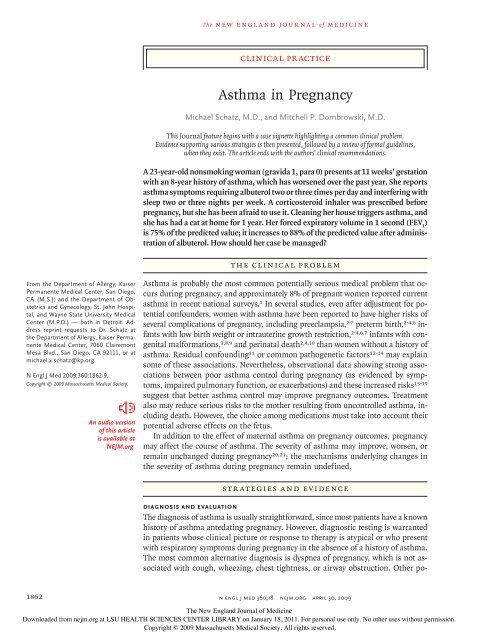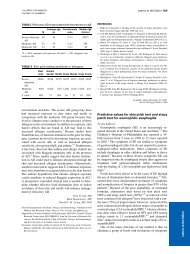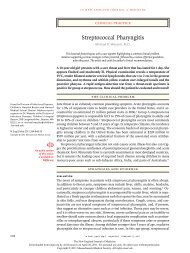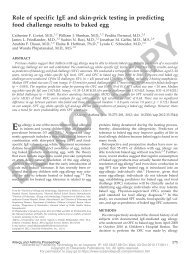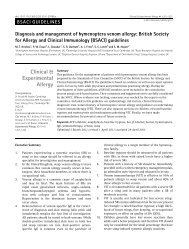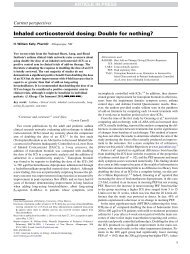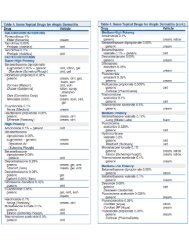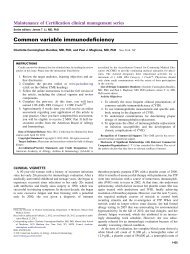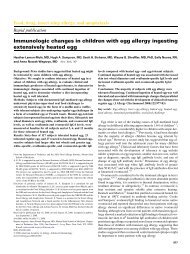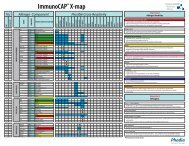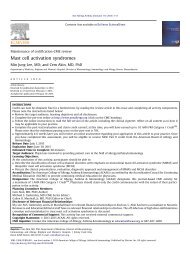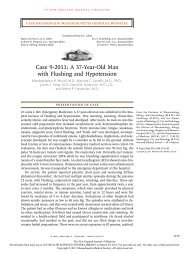Asthma in Pregnancy - NEJM 2009.pdf - AInotes
Asthma in Pregnancy - NEJM 2009.pdf - AInotes
Asthma in Pregnancy - NEJM 2009.pdf - AInotes
You also want an ePaper? Increase the reach of your titles
YUMPU automatically turns print PDFs into web optimized ePapers that Google loves.
The new england journal of medic<strong>in</strong>ecl<strong>in</strong>ical practice<strong>Asthma</strong> <strong>in</strong> <strong>Pregnancy</strong>Michael Schatz, M.D., and Mitchell P. Dombrowski, M.D.This Journal feature beg<strong>in</strong>s with a case vignette highlight<strong>in</strong>g a common cl<strong>in</strong>ical problem.Evidence support<strong>in</strong>g various strategies is then presented, followed by a review of formal guidel<strong>in</strong>es,when they exist. The article ends with the authors’ cl<strong>in</strong>ical recommendations.A 23-year-old nonsmok<strong>in</strong>g woman (gravida 1, para 0) presents at 11 weeks’ gestationwith an 8-year history of asthma, which has worsened over the past year. She reportsasthma symptoms requir<strong>in</strong>g albuterol two or three times per day and <strong>in</strong>terfer<strong>in</strong>g withsleep two or three nights per week. A corticosteroid <strong>in</strong>haler was prescribed beforepregnancy, but she has been afraid to use it. Clean<strong>in</strong>g her house triggers asthma, andshe has had a cat at home for 1 year. Her forced expiratory volume <strong>in</strong> 1 second (FEV 1 )is 75% of the predicted value; it <strong>in</strong>creases to 88% of the predicted value after adm<strong>in</strong>istrationof albuterol. How should her case be managed?The Cl<strong>in</strong>ical ProblemFrom the Department of Allergy, KaiserPermanente Medical Center, San Diego,CA (M.S.); and the Department of Obstetricsand Gynecology, St. John Hospital,and Wayne State University MedicalCenter (M.P.D.) — both <strong>in</strong> Detroit. Addressrepr<strong>in</strong>t requests to Dr. Schatz atthe Department of Allergy, Kaiser PermanenteMedical Center, 7060 ClairemontMesa Blvd., San Diego, CA 92111, or atmichael.x.schatz@kp.org.N Engl J Med 2009;360:1862-9.Copyright © 2009 Massachusetts Medical Society.An audio versionof this articleis available at<strong>NEJM</strong>.org<strong>Asthma</strong> is probably the most common potentially serious medical problem that occursdur<strong>in</strong>g pregnancy, and approximately 8% of pregnant women reported currentasthma <strong>in</strong> recent national surveys. 1 In several studies, even after adjustment for potentialconfounders, women with asthma have been reported to have higher risks ofseveral complications of pregnancy, <strong>in</strong>clud<strong>in</strong>g preeclampsia, 2-7 preterm birth, 2-4,6 <strong>in</strong>fantswith low birth weight or <strong>in</strong>trauter<strong>in</strong>e growth restriction, 2-4,6,7 <strong>in</strong>fants with congenitalmalformations, 3,8,9 and per<strong>in</strong>atal death 2,4,10 than women without a history ofasthma. Residual confound<strong>in</strong>g 11 or common pathogenetic factors 12-14 may expla<strong>in</strong>some of these associations. Nevertheless, observational data show<strong>in</strong>g strong associationsbetween poor asthma control dur<strong>in</strong>g pregnancy (as evidenced by symptoms,impaired pulmonary function, or exacerbations) and these <strong>in</strong>creased risks 15-19suggest that better asthma control may improve pregnancy outcomes. Treatmentalso may reduce serious risks to the mother result<strong>in</strong>g from uncontrolled asthma, <strong>in</strong>clud<strong>in</strong>gdeath. However, the choice among medications must take <strong>in</strong>to account theirpotential adverse effects on the fetus.In addition to the effect of maternal asthma on pregnancy outcomes, pregnancymay affect the course of asthma. The severity of asthma may improve, worsen, orrema<strong>in</strong> unchanged dur<strong>in</strong>g pregnancy 20,21 ; the mechanisms underly<strong>in</strong>g changes <strong>in</strong>the severity of asthma dur<strong>in</strong>g pregnancy rema<strong>in</strong> undef<strong>in</strong>ed.Strategies and EvidenceDiagnosis and EvaluationThe diagnosis of asthma is usually straightforward, s<strong>in</strong>ce most patients have a knownhistory of asthma antedat<strong>in</strong>g pregnancy. However, diagnostic test<strong>in</strong>g is warranted<strong>in</strong> patients whose cl<strong>in</strong>ical picture or response to therapy is atypical or who presentwith respiratory symptoms dur<strong>in</strong>g pregnancy <strong>in</strong> the absence of a history of asthma.The most common alternative diagnosis is dyspnea of pregnancy, which is not associatedwith cough, wheez<strong>in</strong>g, chest tightness, or airway obstruction. Other po-1862n engl j med 360;18 nejm.org april 30, 2009The New England Journal of Medic<strong>in</strong>eDownloaded from nejm.org at LSU HEALTH SCIENCES CENTER LIBRARY on January 18, 2011. For personal use only. No other uses without permission.Copyright © 2009 Massachusetts Medical Society. All rights reserved.
cl<strong>in</strong>ical practicetential diagnoses <strong>in</strong>clude cough due to reflux orpostnasal drip, bronchitis, laryngeal dysfunction,hyperventilation, pulmonary edema, and pulmonaryembolism. 22,23 The demonstration of a reducedFEV 1 or ratio of FEV 1 to forced vital capacitywith a 12% or greater improvement <strong>in</strong> FEV 1after the adm<strong>in</strong>istration of <strong>in</strong>haled albuterol confirmsa diagnosis of asthma <strong>in</strong> pregnancy. 23,24Methachol<strong>in</strong>e test<strong>in</strong>g, which is used to confirmbronchial hyperreactivity <strong>in</strong> patients with normalpulmonary function, is contra<strong>in</strong>dicated dur<strong>in</strong>gpregnancy because of the lack of data on the safetyof such test<strong>in</strong>g <strong>in</strong> pregnant patients. Thus, womenwith a cl<strong>in</strong>ical picture that is consistent withnew-onset asthma <strong>in</strong> whom the diagnosis is notconfirmed on the basis of test<strong>in</strong>g for reversibilityof impairment <strong>in</strong> pulmonary function should betreated for asthma until methachol<strong>in</strong>e test<strong>in</strong>g canbe performed post partum if <strong>in</strong>dicated. 23 Exhalednitric oxide has not been studied as a diagnosticmeasure of asthma <strong>in</strong> pregnant women.Patients with persistent asthma who have notpreviously been tested for allergies should undergoblood test<strong>in</strong>g for specific IgE antibodies to allergenssuch as dust mites, cockroaches, mold spores,and pets. Sk<strong>in</strong> tests are not generally recommendeddur<strong>in</strong>g pregnancy because sk<strong>in</strong> test<strong>in</strong>g withpotent antigens may be associated with systemicreactions.Current asthma control should be assessed accord<strong>in</strong>gto the frequency and severity of symptoms(<strong>in</strong>clud<strong>in</strong>g their <strong>in</strong>terference with sleep and normalactivity), the frequency of use of rescue therapy, thehistory of exacerbations requir<strong>in</strong>g the use of systemiccorticosteroids, and the results of pulmonary-functiontests (Table 1). Spirometry is thepreferred method of assess<strong>in</strong>g pulmonary function,but peak flow measurement is an acceptablealternative. FEV 1 and peak flow rates do notchange substantially as a result of pregnancy, 23 sothese measures can be used for assess<strong>in</strong>g asthmacontrol <strong>in</strong> patients who are pregnant just as theyare <strong>in</strong> patients who are not pregnant. Patients whohave asthma that is well controlled and who arenot receiv<strong>in</strong>g controller medications can be classifiedas hav<strong>in</strong>g <strong>in</strong>termittent rather than persistentasthma.Women who have previously received prescriptionsfor asthma medications should be askedabout their use <strong>in</strong> order to classify their currentlevel of therapy (accord<strong>in</strong>g to a stepped-care approach,with step 1 <strong>in</strong>dicat<strong>in</strong>g no treatment andstep 6 <strong>in</strong>dicat<strong>in</strong>g the most aggressive treatment)(Table 2) and to assess potential problems withand barriers to adherence. Adherence to treatmentwith <strong>in</strong>haled corticosteroids has been reported tobe poor <strong>in</strong> many studies. For example, the reportedadherence rate was approximately 50% <strong>in</strong> onestudy <strong>in</strong>volv<strong>in</strong>g adults with asthma; decreased adherencewas associated with an <strong>in</strong>creased frequencyof asthma exacerbations. 26 Women with asthmahave been reported to decrease their use of <strong>in</strong>haledcorticosteroids dur<strong>in</strong>g early pregnancy, ascompared with their use of these agents <strong>in</strong> the20 weeks before their last menstrual period 27 ; thismay be due to their reported concern regard<strong>in</strong>g thesafety of <strong>in</strong>haled corticosteroids dur<strong>in</strong>g pregnancy.28 Moreover, a substantial proportion of asthmaticexacerbations dur<strong>in</strong>g pregnancy have beenassociated with nonadherence to treatment with<strong>in</strong>haled corticosteroids. 29 In addition to assess<strong>in</strong>gadherence, ask<strong>in</strong>g about past medications andtheir effectiveness and any side effects can help toguide subsequent management decisions.Management of <strong>Asthma</strong>All patients should be educated regard<strong>in</strong>g the relationshipbetween asthma and pregnancy, andthey should be taught about self-treatment, <strong>in</strong>clud<strong>in</strong>g<strong>in</strong>haler techniques, adherence to medication,and control of potential environmental triggers(Table 3). The appropriate management of commoncoexist<strong>in</strong>g conditions that can aggravate asthma,such as rh<strong>in</strong>itis, s<strong>in</strong>usitis, and gastroesophagealreflux, can improve asthma control. Women whosmoke must be <strong>in</strong>formed of the potential adverseeffects of smok<strong>in</strong>g on the fetus, which may addto the fetal effects of uncontrolled asthma, 15 andshould be strongly encouraged to quit. Advice onenvironmental control measures for reduc<strong>in</strong>g exposureto allergens can be provided on the basisof the results of allergy test<strong>in</strong>g (Table 4).Medications for asthma are divided <strong>in</strong>to longtermcontroller medications that prevent the manifestationsof asthma (<strong>in</strong>haled corticosteroids,long-act<strong>in</strong>g β-agonists, leukotriene modifiers, cromolyn,and theophyll<strong>in</strong>e) (Table 5) and rescuetherapy that provides quick relief of symptoms(primarily short-act<strong>in</strong>g <strong>in</strong>haled β-agonists). Instudies <strong>in</strong>volv<strong>in</strong>g patients who were not pregnant,<strong>in</strong>haled corticosteroids were the most effectivecontroller medications <strong>in</strong> terms of reduc<strong>in</strong>g symptomsand exacerbations and improv<strong>in</strong>g pulmonaryfunction, and all controller medications have beenn engl j med 360;18 nejm.org april 30, 2009 1863The New England Journal of Medic<strong>in</strong>eDownloaded from nejm.org at LSU HEALTH SCIENCES CENTER LIBRARY on January 18, 2011. For personal use only. No other uses without permission.Copyright © 2009 Massachusetts Medical Society. All rights reserved.
The new england journal of medic<strong>in</strong>eTable 1. Assessment of <strong>Asthma</strong> Control <strong>in</strong> Pregnant Women.*VariableWell-Controlled<strong>Asthma</strong><strong>Asthma</strong> NotWell ControlledVery PoorlyControlled <strong>Asthma</strong>Frequency of symptoms ≤2 days/wk >2 days/wk Throughout the dayFrequency of nighttime awaken<strong>in</strong>g ≤2 times/mo 1–3 times/wk ≥4 times/wkInterference with normal activity None Some ExtremeUse of short-act<strong>in</strong>g β-agonist for symptomcontrolFEV 1 or peak flow (% of the predicted orpersonal best value)Exacerbations requir<strong>in</strong>g use of systemiccorticosteroid (no.)≤2 days/wk >2 days/wk Several times/day>80 60–80
cl<strong>in</strong>ical practiceof long-act<strong>in</strong>g β-agonists dur<strong>in</strong>g pregnancy, althoughthe <strong>in</strong>halational route and the generallyreassur<strong>in</strong>g data on short-act<strong>in</strong>g β-agonists suggestthat these agents are probably safe. 25 A possibleassociation between long-act<strong>in</strong>g β-agonistsand an <strong>in</strong>creased risk of severe and even fatalasthma exacerbations has been observed <strong>in</strong> patientswho were not pregnant. Although the dataare sparse, expert panels suggest that the benefitsof the use of long-act<strong>in</strong>g β-agonists appearto outweigh the risks as long as they are usedconcurrently with <strong>in</strong>haled corticosteroids. 44,45Overall, the risks associated with asthma medications<strong>in</strong> current use are considered to be def<strong>in</strong>itelylower than the risks associated with uncontrolledasthma.It is appropriate for pregnant patients with wellcontrolledasthma to cont<strong>in</strong>ue tak<strong>in</strong>g their medications.In patients who are not pregnant and whohave asthma that has been controlled for at least3 months with the use of controller medications,guidel<strong>in</strong>es recommend consideration of a stepdown <strong>in</strong> therapy 24 ; however, it may be prudent toma<strong>in</strong>ta<strong>in</strong> the current level of therapy dur<strong>in</strong>g pregnancy<strong>in</strong> order to reduce the risk of a loss of control.For patients at step 5 or 6 (Table 2), a carefulreduction <strong>in</strong> therapy may be considered if theprevious course of asthma and the course dur<strong>in</strong>gpregnancy suggest that a reduction is likely to betolerated without a loss of control.Therapy should be <strong>in</strong>creased by one step (Table2) <strong>in</strong> patients with asthma that is not well controlleddespite consideration of the nonpharmacologicstrategies described above. A two-step <strong>in</strong>crease,a course of oral corticosteroids, or bothshould be recommended for women with asthmathat is very poorly controlled.Monthly visits to assess asthma control arerecommended for women who require controllertherapy dur<strong>in</strong>g pregnancy. This assessmentmay be performed as part of rout<strong>in</strong>e obstetricalvisits or by the primary care physician or asthmaspecialist who is manag<strong>in</strong>g the patient’s asthma.Patients with very poorly controlled asthmashould be seen every 1 to 2 weeks until controlis achieved.Table 2. Steps of <strong>Asthma</strong> Therapy dur<strong>in</strong>g <strong>Pregnancy</strong>.*StepPreferredController Medication<strong>Asthma</strong> ExacerbationsAn asthma exacerbation <strong>in</strong> a pregnant patient, as<strong>in</strong> any adult, should be managed with <strong>in</strong>haledβ-agonists, <strong>in</strong>haled antichol<strong>in</strong>ergic drugs, andsystemic corticosteroids. 23,24 Ma<strong>in</strong>tenance of anarterial oxygen saturation of at least 95%, measuredby means of pulse oximetry, is recommendedto ensure sufficient oxygenation <strong>in</strong> both themother and the fetus. 22 Assessment of the fetusdur<strong>in</strong>g an acute asthma episode depends on thestage of the pregnancy, but cont<strong>in</strong>uous electronicfetal monitor<strong>in</strong>g, a biophysical profile, or bothshould be considered if the fetus has reached thestage of viability. 23 A biophysical profile <strong>in</strong>cludesa nonstress test for a reactive fetal heart rate, ul-AlternativeController Medication1 None —2 Low-dose <strong>in</strong>haled corticosteroid LTRA, theophyll<strong>in</strong>e, or cromolyn3 Medium-dose <strong>in</strong>haled corticosteroid4 Medium-dose <strong>in</strong>haled corticosteroidplus LABA5 High-dose <strong>in</strong>haled cortico steroidplus LABA6 High-dose <strong>in</strong>haled corticosteroidplus LABA plus oral prednisoneLow-dose <strong>in</strong>haled corticosteroidplus LABA, LTRA, or theophyll<strong>in</strong>eMedium-dose <strong>in</strong>haled corticosteroidplus either LTRA or theophyll<strong>in</strong>e* Data are from the National <strong>Asthma</strong> Education and Prevention Program. 24,25We have modified step 3 to reflect the choice of a medium-dose <strong>in</strong>haled corticosteroidover a low-dose <strong>in</strong>haled corticosteroid plus a long-act<strong>in</strong>g β-agonist(LABA) because of the lack of safety data on the use of LABA dur<strong>in</strong>g pregnancy.LTRA denotes leukotriene-receptor antagonist.Table 3. Patient Education for Self-Treatment of <strong>Asthma</strong> dur<strong>in</strong>g <strong>Pregnancy</strong>.SubjectGeneral <strong>in</strong>formationUse of <strong>in</strong>haler deviceAdherence to treatmentSelf-treatment actionplanRecommendationProvide basic <strong>in</strong>formation about asthma and relationshipbetween asthma and pregnancyDemonstrate proper technique for specific deviceand ask patient to perform the technique; demonstrateuse of spacer device for metered-dose<strong>in</strong>haler if patient’s <strong>in</strong>haler technique is suboptimalDiscuss self-reported adherence to treatment withcontroller medication and, if needed, addressbarriers to optimal adherence (e.g., cost, convenience,concern about side effects)Provide schedule for ma<strong>in</strong>tenance medication anddoses of rescue therapy for <strong>in</strong>creased symptoms;expla<strong>in</strong> when and how to <strong>in</strong>crease controllermedication and when and how to useprednisone (for patients with previous prednisoneuse or poorly controlled asthma); expla<strong>in</strong>how to recognize a severe exacerbationand when and how to seek urgent or emergencycare——n engl j med 360;18 nejm.org april 30, 2009 1865The New England Journal of Medic<strong>in</strong>eDownloaded from nejm.org at LSU HEALTH SCIENCES CENTER LIBRARY on January 18, 2011. For personal use only. No other uses without permission.Copyright © 2009 Massachusetts Medical Society. All rights reserved.
The new england journal of medic<strong>in</strong>eTable 4. Environmental Control Measures to Reduce Exposure to Allergens.*Allergen Instructions Level of EvidenceAnimal danderDust mitesCockroachesRemove pet from house;if removal not acceptable,keep pet out ofbedroomEncase pillow and mattresswith impermeable covers;wash sheets andblankets weekly <strong>in</strong> hotwaterDo not leave food or garbageexposed; use poisonbaits or traps ratherthan chemical agents,which can aggravateasthmaConsensus judgmentData from several randomized,controlled trialsFew randomized, controlledtrials* Data are from the National <strong>Asthma</strong> Education and Prevention Program. 24These data are not specific to pregnancy.trasonographic measurement of amniotic-fluidvolume, observation of the presence or absenceof fetal breath<strong>in</strong>g movements, and observation ofgross body movements and fetal tone. If oxygensaturation rema<strong>in</strong>s below a level of at least 95%(as measured by means of pulse oximetry) whilethe patient is breath<strong>in</strong>g ambient air, if FEV 1 or peakexpiratory flow rema<strong>in</strong>s below 70% of the predictedvalue, or if there is evidence of fetal compromise,the patient should be hospitalized, withcareful medical and obstetrical surveillance. 22,23This pulmonary-function criterion, which is basedon general recommendations for asthmatic exacerbations,is supported by some observationaldata, 24 although we are aware of no specific data<strong>in</strong> pregnant women with asthma.Obstetrical CareIn general, data are lack<strong>in</strong>g on the optimal obstetricalcare of patients with asthma, and recommendationsare based on extrapolation of datafrom other cl<strong>in</strong>ical sett<strong>in</strong>gs and expert op<strong>in</strong>ion.Women with asthma that is not well controlled maybenefit from <strong>in</strong>creased fetal surveillance. Ultrasonographicexam<strong>in</strong>ations can be helpful to establishaccurate pregnancy dat<strong>in</strong>g and monitorfetal growth, which (as described above) can beaffected by uncontrolled asthma. Assessment offetal well-be<strong>in</strong>g, usually by means of nonstress test<strong>in</strong>g,should be considered, start<strong>in</strong>g at 32 weeks’gestation. 23Adequate hydration and analgesia should bema<strong>in</strong>ta<strong>in</strong>ed dur<strong>in</strong>g labor and delivery; analgesiashould not compromise the patient’s respiratorystatus, and <strong>in</strong>sufficient pa<strong>in</strong> control could triggerbronchospasm. Use of asthma medications shouldbe cont<strong>in</strong>ued dur<strong>in</strong>g labor and delivery. It is commonlyrecommended that women who are currentlytak<strong>in</strong>g systemic corticosteroids or who havereceived several short courses of systemic corticosteroidsdur<strong>in</strong>g pregnancy receive <strong>in</strong>travenouscorticosteroids (e.g., hydrocortisone at a dose of100 mg every 8 hours) dur<strong>in</strong>g labor and for 24hours after delivery <strong>in</strong> order to prevent adrenalcrisis. 22 Prostagland<strong>in</strong> E 1 or E 2 can be used forcervical ripen<strong>in</strong>g, management of spontaneous or<strong>in</strong>duced abortions, or postpartum hemorrhage,although the patient’s respiratory status shouldbe monitored for bronchospasm. 46 In contrast,carboprost (15-methyl prostagland<strong>in</strong> F 2 α) and ergonov<strong>in</strong>emay trigger bronchospasm and shouldbe avoided, if possible. 22 If tocolysis is required,magnesium sulfate and terbutal<strong>in</strong>e are preferablebecause they are bronchodilators; <strong>in</strong> contrast, <strong>in</strong>domethac<strong>in</strong>can <strong>in</strong>duce bronchospasm <strong>in</strong> a patientwith aspir<strong>in</strong>-sensitive asthma. 22Cesarean delivery is rarely required <strong>in</strong> patientswith an acute asthmatic exacerbation; maternaland fetal compromise usually responds to aggressivemedical management. Lumbar anesthesia canreduce oxygen consumption and m<strong>in</strong>ute ventilationdur<strong>in</strong>g labor. 47 The obstetrician, anesthesiologist,and pediatrician should coord<strong>in</strong>ate <strong>in</strong>trapartumand postpartum care. In general, onlysmall amounts of the asthma medications listed<strong>in</strong> Table 5 enter breast milk; none are a contra<strong>in</strong>dicationto breast-feed<strong>in</strong>g. 23,25Areas of Uncerta<strong>in</strong>tyThe mechanisms l<strong>in</strong>k<strong>in</strong>g poorly controlled asthmato adverse per<strong>in</strong>atal outcomes rema<strong>in</strong> unclear. Itis not possible <strong>in</strong> observational studies to def<strong>in</strong>itelydist<strong>in</strong>guish the potential contributions of<strong>in</strong>creased asthma severity and poor asthma controlfrom the potential effects of medications used<strong>in</strong> more severe cases. Because of the ethical issuesraised, controlled trials cannot be performed todeterm<strong>in</strong>e the effects of asthma control, as comparedwith lack of control, on per<strong>in</strong>atal outcomes.Controlled trials are unlikely to be large enoughto determ<strong>in</strong>e the absolute safety of various asthmamedications dur<strong>in</strong>g pregnancy, especially with regardto uncommon outcomes such as specific congenitalmalformations.1866n engl j med 360;18 nejm.org april 30, 2009The New England Journal of Medic<strong>in</strong>eDownloaded from nejm.org at LSU HEALTH SCIENCES CENTER LIBRARY on January 18, 2011. For personal use only. No other uses without permission.Copyright © 2009 Massachusetts Medical Society. All rights reserved.
cl<strong>in</strong>ical practiceTable 5. Controller Medications for the Management of <strong>Asthma</strong> dur<strong>in</strong>g <strong>Pregnancy</strong>.*Drug Usual Dose Potential Adverse EffectsInhaled corticosteroidsBudesonideBeclomethasoneFluticasoneLow: 180–600 µg/day; medium:>600–1200 µg/day;high: >1200 µg/dayLow: 80–240 µg/day; medium:>240–480 µg/day; high:>480 µg/dayLow: 100–300 µg/day; medium:>300–500 µg/day;high: >500 µg/dayCough, dysphonia, thrush; potentialsystemic effects athigh doses; local side effectsdecreased with valvedhold<strong>in</strong>g chamber (spacer)for metered-dose <strong>in</strong>halersthat are not breath-actuatedand with mouth wash<strong>in</strong>gand spitt<strong>in</strong>g after <strong>in</strong>halationFDA<strong>Pregnancy</strong>Class†Long-act<strong>in</strong>g β-agonistsTachycardia, skeletal-muscleSalmeterol 1 blister twice dailytremor, hypokalemia; possible<strong>in</strong>crease <strong>in</strong> risk ofsevere, life-threaten<strong>in</strong>g,or fatal exacerbationCFormoterol 1 capsule twice daily CLeukotriene- receptor antagonistsMontelukast 10 mg daily No major adverse effects identifiedZafirlukast 20 mg twice daily Cases of hepatitis reported B∥Recommended Use‡Preferred controller therapyB§ Preferred <strong>in</strong>haled corticosteroidbecause of more reassur<strong>in</strong>gdata <strong>in</strong> humansCCPreferred add-on therapy tomedium- or high-dose<strong>in</strong>haled corticosteroidsAlternative for mild asthmaor as add-on therapy to<strong>in</strong>haled corticosteroids,especially <strong>in</strong> patientswith good responsebefore pregnancyCromolyn 2 puffs four times daily Cough B∥ Alternative for mild asthmaTheophyll<strong>in</strong>e400–600 mg/day (based ontheophyll<strong>in</strong>e level)Insomnia, gastric upset, aggravationof gastroesophagealrefluxB∥C Alternative for mild asthmaor as add-on therapy to<strong>in</strong>haled corticosteroids* Data are from the National <strong>Asthma</strong> Education and Prevention Program. 24,25 FDA denotes Food and Drug Adm<strong>in</strong>istration.† A pregnancy rat<strong>in</strong>g of B <strong>in</strong>dicates that reassur<strong>in</strong>g data from studies <strong>in</strong> animals or humans have been submitted to the FDA, and a rat<strong>in</strong>gof C that a risk to the fetus cannot be ruled out on the basis of submitted data.‡ Data are based on relative efficacy <strong>in</strong> all patients with asthma and safety data <strong>in</strong> pregnant women.§ Data are based on nonreassur<strong>in</strong>g studies of systemic adm<strong>in</strong>istration <strong>in</strong> animals, but reassur<strong>in</strong>g data <strong>in</strong> humans have been submitted tothe FDA. Data are based on nonreassur<strong>in</strong>g studies of systemic adm<strong>in</strong>istration <strong>in</strong> animals, and no data <strong>in</strong> humans have been submitted to the FDA.∥ Data are based on reassur<strong>in</strong>g studies <strong>in</strong> animals, but no data <strong>in</strong> humans have been submitted to the FDA.Guidel<strong>in</strong>esNational guidel<strong>in</strong>es for the management of asthmadur<strong>in</strong>g pregnancy were most recently updated<strong>in</strong> 2004, 25 and general guidel<strong>in</strong>es for the managementof asthma <strong>in</strong> all patients were updated<strong>in</strong> 2007. 24 The American College of Obstetriciansand Gynecologists published guidel<strong>in</strong>es on thecl<strong>in</strong>ical management of asthma dur<strong>in</strong>g pregnancy<strong>in</strong> 2008. 23 The recommendations <strong>in</strong> this articleare consistent with these guidel<strong>in</strong>es.Conclusionsand RecommendationsAlthough uncontrolled asthma may <strong>in</strong>crease therisk of adverse per<strong>in</strong>atal outcomes, women withwell-controlled asthma <strong>in</strong> pregnancy generally havegood pregnancy outcomes. 48-50 The patient described<strong>in</strong> the vignette has poorly controlled asthma,as evidenced by daily symptoms and daily useof rescue therapy, asthma that <strong>in</strong>terferes with sleepmore than once a week, and an FEV 1 of less thann engl j med 360;18 nejm.org april 30, 2009 1867The New England Journal of Medic<strong>in</strong>eDownloaded from nejm.org at LSU HEALTH SCIENCES CENTER LIBRARY on January 18, 2011. For personal use only. No other uses without permission.Copyright © 2009 Massachusetts Medical Society. All rights reserved.
The new england journal of medic<strong>in</strong>e80% of the predicted value. This patient shouldbe educated regard<strong>in</strong>g the potential risks of uncontrolledasthma for herself and her pregnancy.We would recommend test<strong>in</strong>g for sensitivity tomites, cat dander, and cockroach allergens and<strong>in</strong>itiate medium-dose <strong>in</strong>haled corticosteroids(a two-step therapy <strong>in</strong>crease). We would choose<strong>in</strong>haled budesonide (180 µg per puff, two puffstwice a day) over other <strong>in</strong>haled corticosteroids becausemore safety data are available on the use ofthis drug dur<strong>in</strong>g the gestational period. The patientshould also be <strong>in</strong>structed <strong>in</strong> the use of anoptimal <strong>in</strong>haler technique, and she should be givena personalized self-treatment action plan forasthma that <strong>in</strong>cludes <strong>in</strong>structions regard<strong>in</strong>g thema<strong>in</strong>tenance medication schedule, doses of rescuetherapy for <strong>in</strong>creased symptoms, and whenand how to seek urgent or emergency care. Wewould recommend follow-up every 1 to 2 weeks<strong>in</strong>itially to ensure that asthma control is achievedand then, once the patient’s condition is stable,at least monthly throughout the pregnancy.Dr. Schatz reports receiv<strong>in</strong>g consult<strong>in</strong>g fees from Glaxo-SmithKl<strong>in</strong>e and grant support from Aerocr<strong>in</strong>e, Genentech,GlaxoSmithKl<strong>in</strong>e, and Merck. No other potential conflict of <strong>in</strong>terestrelevant to this article was reported.References1. Kwon HL, Triche EW, Belanger K,Bracken MB. The epidemiology of asthmadur<strong>in</strong>g pregnancy: prevalence, diagnosis,and symptoms. Immunol Allergy Cl<strong>in</strong>North Am 2006;26:29-62.2. Bahna SL, Bjerkedal T. The course andoutcome of pregnancy <strong>in</strong> women withbronchial asthma. Acta Allergol 1972;27:397-406.3. Demissie K, Breckenridge MB, RhoadsGG. Infant and maternal outcomes <strong>in</strong> thepregnancies of asthmatic women. Am JRespir Crit Care Med 1998;158:1091-5.4. Källén B, Rydhstroem H, Aberg A.<strong>Asthma</strong> dur<strong>in</strong>g pregnancy — a populationbased study. Eur J Epidemiol 2000;16:167-71.5. Wen SW, Demissie K, Liu S. Adverseoutcomes <strong>in</strong> pregnancies of asthmaticwomen: results from a Canadian population.Ann Epidemiol 2001;11:7-12.6. Liu S, Wen SW, Demissie K, MarcouxS, Kramer MS. Maternal asthma andpregnancy outcomes: a retrospective cohortstudy. Am J Obstet Gynecol 2001;184:90-6.7. Enriquez R, Griff<strong>in</strong> MR, Carroll KN,et al. Effect of maternal asthma and asthmacontrol on pregnancy and per<strong>in</strong>ataloutcomes. J Allergy Cl<strong>in</strong> Immunol 2007;120:625-30.8. Tamási L, Somoskövi A, Müller V, etal. A population-based case-control studyon the effect of bronchial asthma dur<strong>in</strong>gpregnancy for congenital abnormalities<strong>in</strong> the offspr<strong>in</strong>g. J <strong>Asthma</strong> 2006;43:81-6.9. Källén B, Otterblad Olausson P. Useof anti-asthmatic drugs dur<strong>in</strong>g pregnancy.3. Congenital malformations <strong>in</strong> the <strong>in</strong>fants.Eur J Cl<strong>in</strong> Pharmacol 2007;63:383-8.10. Breton MC, Beauchesne M-F, LemièreC, Rey E, Forget A, Blais L. Risk of per<strong>in</strong>atalmortality associated with asthma dur<strong>in</strong>gpregnancy. Thorax 2009;64:101-6.11. Hendler I, Schatz M, Momirova V, etal. Association of obesity with pulmonaryand nonpulmonary complications of pregnancy<strong>in</strong> asthmatic women. Obstet Gynecol2006;108:77-82.12. Bertrand J-M, Riley SP, Popk<strong>in</strong> J,Coates AL. The long-term pulmonary sequelaeof prematurity: the role of familialairway hyperreactivity and the respiratorydistress syndrome. N Engl J Med 1985;312:742-5.13. Riedel F, Achenbach U, Rieger CHL.Prematurity and maternal bronchial hyperresponsiveness.J Per<strong>in</strong>at Med 1989;17:151-5.14. Siddiqui S, Goodman N, McKenna S,Goldie M, Waugh J, Brightl<strong>in</strong>g CE. Preeclampsiais associated with airway hyperresponsiveness.BJOG 2008;115:520-2.15. Schatz M, Zeiger RS, Hoffman CP. Intrauter<strong>in</strong>egrowth is related to gestationalpulmonary function <strong>in</strong> pregnant asthmaticwomen. Chest 1990;98:389-92.16. Bracken MB, Triche EW, Belanger K,Saflas A, Beckett WS, Leaderer BP. <strong>Asthma</strong>symptoms, severity, and drug therapy:a prospective study of effects on 2205pregnancies. Obstet Gynecol 2003;102:739-52.17. Bakhireva LN, Schatz M, Jones KL,Chambers CD. <strong>Asthma</strong> control dur<strong>in</strong>gpregnancy and the risk of preterm deliveryor impaired fetal growth. Ann Allergy<strong>Asthma</strong> Immunol 2008;101:137-43.18. Schatz M, Dombrowski MP, Wise R,et al. Spirometry is related to per<strong>in</strong>atal outcomes<strong>in</strong> pregnant women with asthma.Am J Obstet Gynecol 2006;194:120-6.19. Murphy VE, Clifton VL, Gibson PG.<strong>Asthma</strong> exacerbations dur<strong>in</strong>g pregnancy:<strong>in</strong>cidence and association with adversepregnancy outcomes. Thorax 2006;61:169-76.20. Gluck JC, Gluck PA. The effect of pregnancyon the course of asthma. ImmunolAllergy Cl<strong>in</strong> North Am 2006;26:63-80.21. Schatz M, Dombrowski MP, Wise R, etal. <strong>Asthma</strong> morbidity dur<strong>in</strong>g pregnancycan be predicted by severity classification.J Allergy Cl<strong>in</strong> Immunol 2003;112:283-8.22. National <strong>Asthma</strong> Education Programreport of the Work<strong>in</strong>g Group on <strong>Asthma</strong>and <strong>Pregnancy</strong>: management of asthmadur<strong>in</strong>g pregnancy. Bethesda, MD: NationalHeart, Lung, and Blood Institute, September1993. (NIH publication no. 93-3279.)23. ACOG practice bullet<strong>in</strong>: cl<strong>in</strong>ical managementguidel<strong>in</strong>es for obstetrician-gynecologistsnumber 90, February 2008: asthma<strong>in</strong> pregnancy. Obstet Gynecol 2008;111:457-64.24. National <strong>Asthma</strong> Education and PreventionProgram. Expert panel report 3:guidel<strong>in</strong>es for the diagnosis and managementof asthma: full report 2007. (AccessedApril 6, 2009, at http://www.nhlbi.nih.gov/guidel<strong>in</strong>es/asthma/asthgdln.pdf.)25. NAEPP expert panel report: manag<strong>in</strong>gasthma dur<strong>in</strong>g pregnancy: recommendationsfor pharmacologic treatment — 2004update. J Allergy Cl<strong>in</strong> Immunol 2005;115:34-46. [Erratum, J Allergy Cl<strong>in</strong> Immunol2005;115:477.]26. Williams LK, Pladevall M, Xi H, et al.Relationship between adherence to <strong>in</strong>haledcorticosteroids and poor outcomesamong adults with asthma. J Allergy Cl<strong>in</strong>Immunol 2004;114:1288-93.27. Enriquez R, Wu P, Griff<strong>in</strong> MR, et al.Cessation of asthma medication <strong>in</strong> earlypregnancy. Am J Obstet Gynecol 2006;195:149-53.28. Chambers K. <strong>Asthma</strong> education andoutcomes for women of childbear<strong>in</strong>g age.Case Manager 2003;14:58-61.29. Murphy VE, Gibson P, Talbot PI, CliftonVL. Severe asthma exacerbations dur<strong>in</strong>gpregnancy. Obstet Gynecol 2005;106:1046-54.30. Dombrowski MP, Schatz M, Wise R, etal. Randomized trial of <strong>in</strong>haled beclomethasonedipropionate versus theophyll<strong>in</strong>efor moderate asthma dur<strong>in</strong>g pregnancy.Am J Obstet Gynecol 2004;190:737-44.31. Wendel PJ, Ram<strong>in</strong> SM, Barnett-HammX, Rowe TF, Cunn<strong>in</strong>gham FG. <strong>Asthma</strong>1868n engl j med 360;18 nejm.org april 30, 2009The New England Journal of Medic<strong>in</strong>eDownloaded from nejm.org at LSU HEALTH SCIENCES CENTER LIBRARY on January 18, 2011. For personal use only. No other uses without permission.Copyright © 2009 Massachusetts Medical Society. All rights reserved.
cl<strong>in</strong>ical practicetreatment <strong>in</strong> pregnancy: a randomizedcontrolled trial. Am J Obstet Gynecol1996;175:150-4.32. Schatz M, Zeiger RS, Harden K, HoffmanCC, Chil<strong>in</strong>gar L, Petitti D. The safetyof asthma and allergy medications dur<strong>in</strong>gpregnancy. J Allergy Cl<strong>in</strong> Immunol 1997;100:301-6.33. Schatz M, Dombrowski MP, Wise R,et al. The relationship of asthma medicationuse to per<strong>in</strong>atal outcomes. J AllergyCl<strong>in</strong> Immunol 2004;113:1040-5.34. Martel M-J, Rey E, Beauchesne M-F, etal. Use of <strong>in</strong>haled corticosteroids dur<strong>in</strong>gpregnancy and risk of pregnancy-<strong>in</strong>ducedhypertension: nested case-control study.BMJ 2005;330:230-6.35. Bakhireva LN, Jones KL, Schatz M, etal. <strong>Asthma</strong> medication use <strong>in</strong> pregnancyand fetal growth. J Allergy Cl<strong>in</strong> Immunol2005;116:503-9.36. Martel M-J, Rey E, Beauchesne M-F, etal. Use of short-act<strong>in</strong>g β 2-agonists dur<strong>in</strong>gpregnancy and the risk of pregnancy<strong>in</strong>ducedhypertension. J Allergy Cl<strong>in</strong> Immunol2007;119:576-82.37. Källén B, Rydhstroem H, Aberg A.Congenital malformations after the useof <strong>in</strong>haled budesonide <strong>in</strong> early pregnancy.Obstet Gynecol 1999;93:392-5.38. Norjavaara E, de Verdier MG. Normalpregnancy outcomes <strong>in</strong> a populationbasedstudy <strong>in</strong>clud<strong>in</strong>g 2,968 pregnantwomen exposed to budesonide. J AllergyCl<strong>in</strong> Immunol 2003;111:736-42.39. L<strong>in</strong> S, Munsie JPW, Herdt-Losavio ML,et al. Maternal asthma medication useand the risk of gastroschisis. Am J Epidemiol2008;168:73-9.40. Blais L, Forget A. <strong>Asthma</strong> exacerbationsdur<strong>in</strong>g the first trimester of pregnancyand the risk of congenital malformationsamong asthmatic women. J AllergyCl<strong>in</strong> Immunol 2008;121:1379-84.41. Stothard KJ, Tennant PWG, Bell R,Rank<strong>in</strong> J. Maternal overweight and obesityand the risk of congenital anomalies:a systematic review and meta-analysis.JAMA 2009;301:636-50.42. Yang J, Carmichael SL, Canfield M,Song J, Shaw GM. Socioeconomic status<strong>in</strong> relation to selected birth defects <strong>in</strong> alarge multicentered US case-control study.Am J Epidemiol 2008;167:145-54.43. Bakhireva LN, Jones KL, Schatz M, etal. Safety of leukotriene receptor antagonists<strong>in</strong> pregnancy. J Allergy Cl<strong>in</strong> Immunol2007;119:618-25.44. Jaeschke R, O’Byrne PM, Mejza F, etal. The safety of long-act<strong>in</strong>g β-agonistsamong patients with asthma us<strong>in</strong>g <strong>in</strong>haledcorticosteroids: systematic reviewand metaanalysis. Am J Respir Crit CareMed 2008;178:1009-16.45. Nelson HS, Carr W, Nathan R, PortnoyJM. Update on the safety of long-act<strong>in</strong>gβ-agonists <strong>in</strong> comb<strong>in</strong>ation with <strong>in</strong>haledcorticosteroids for the treatment ofasthma. Ann Allergy <strong>Asthma</strong> Immunol2009;102:11-5.46. Towers CV, Briggs GG, Rojas JA. Theuse of prostagland<strong>in</strong> E2 <strong>in</strong> pregnant patientswith asthma. Am J Obstet Gynecol2004;190:1777-80.47. Hägerdal M, Morgan CW, Sumner AE,Gutsche BB. M<strong>in</strong>ute ventilation and oxygenconsumption dur<strong>in</strong>g labor with epiduralanalgesia. Anesthesiology 1983;59:425-7.48. Schatz M, Zeiger RS, Hoffman CP, etal. Per<strong>in</strong>atal outcomes <strong>in</strong> the pregnanciesof asthmatic women: a prospective controlledanalysis. Am J Respir Crit Care Med1995;151:1170-4.49. Stenius-Aarniala BSM, Hedman J,Teramo KA. Acute asthma dur<strong>in</strong>g pregnancy.Thorax 1996;51:411-4.50. Dombrowski MP, Schatz M, Wise R,et al. <strong>Asthma</strong> dur<strong>in</strong>g pregnancy. ObstetGynecol 2004;103:5-12.Copyright © 2009 Massachusetts Medical Society.COLLECTIONS OF ARTICLES ON THE JOURNAL’S WEB SITEThe Journal’s Web site (<strong>NEJM</strong>.org) sorts published articles <strong>in</strong>tomore than 50 dist<strong>in</strong>ct cl<strong>in</strong>ical collections, which can be used as conveniententry po<strong>in</strong>ts to cl<strong>in</strong>ical content. In each collection, articles are cited <strong>in</strong> reversechronologic order, with the most recent first.n engl j med 360;18 nejm.org april 30, 2009 1869The New England Journal of Medic<strong>in</strong>eDownloaded from nejm.org at LSU HEALTH SCIENCES CENTER LIBRARY on January 18, 2011. For personal use only. No other uses without permission.Copyright © 2009 Massachusetts Medical Society. All rights reserved.


